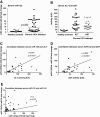Increased microRNA-155 expression in the serum and peripheral monocytes in chronic HCV infection
- PMID: 22846613
- PMCID: PMC3477071
- DOI: 10.1186/1479-5876-10-151
Increased microRNA-155 expression in the serum and peripheral monocytes in chronic HCV infection
Abstract
Background: Hepatitis C Virus (HCV), a single stranded RNA virus, affects millions of people worldwide and leads to chronic infection characterized by chronic inflammation in the liver and in peripheral immune cells. Chronic liver inflammation leads to progressive liver damage. MicroRNAs (miRNA) regulate inflammation (miR-155, -146a and -125b) as well as hepatocyte function (miR-122).
Methods: Here we hypothesized that microRNAs are dysregulated in chronic HCV infection. We examined miRNAs in the circulation and in peripheral monocytes of patients with chronic HCV infection to evaluate if specific miRNA expression correlated with HCV infection.
Results: We found that monocytes from chronic HCV infected treatment-naïve (cHCV) but not treatment responder patients showed increased expression of miR-155, a positive regulator of TNFα, and had increased TNFα production compared to monocytes of normal controls. After LPS stimulation, miR-155 levels were higher in monocytes from cHCV patients compared to controls. MiR-125b, which has negative regulatory effects on inflammation, was decreased in cHCV monocytes compared to controls. Stimulation of normal monocytes with TLR4 and TLR8 ligands or HCV core, NS3 and NS5 recombinant proteins induced a robust increase in both miR-155 expression and TNFα production identifying potential mechanisms for in vivo induction of miR-155. Furthermore, we found increased serum miR-155 levels in HCV patients compared to controls. Serum miR-125b and miR-146a levels were also increased in HCV patients. Serum levels of miR-122 were elevated in cHCV patients and correlated with increased ALT and AST levels and serum miR-155 levels.
Conclusion: In conclusion, our novel data demonstrate that miR-155, a positive regulator of inflammation, is upregulated both in monocytes and in the serum of patients with chronic HCV infection. Our study suggests that HCV core, NS3, and NS5 proteins or TLR4 and TLR8 ligands can mediate increased miR-155 and TNFα production in chronic HCV infection. The positive correlation between serum miR-155 and miR-122 increase in cHCV may be an indicator of inflammation-induced hepatocyte damage.
Figures






Similar articles
-
Viral and host factors induce macrophage activation and loss of toll-like receptor tolerance in chronic HCV infection.Gastroenterology. 2007 Nov;133(5):1627-36. doi: 10.1053/j.gastro.2007.08.003. Epub 2007 Aug 2. Gastroenterology. 2007. PMID: 17916356 Free PMC article.
-
Involvement of TLR2-MyD88 in abnormal expression of miR-146a in peripheral blood monocytes of patients with chronic hepatitis C.J Huazhong Univ Sci Technolog Med Sci. 2015 Apr;35(2):219-224. doi: 10.1007/s11596-015-1414-5. Epub 2015 Apr 16. J Huazhong Univ Sci Technolog Med Sci. 2015. PMID: 25877355
-
Circulating microRNAs as potential biomarkers of physical activity in geriatric patients with HCV.BMC Mol Cell Biol. 2024 Jul 19;25(1):18. doi: 10.1186/s12860-024-00514-8. BMC Mol Cell Biol. 2024. PMID: 39030480 Free PMC article.
-
Elevated serum microRNA-122/222 levels are potential diagnostic biomarkers in Egyptian patients with chronic hepatitis C but not hepatic cancer.Tumour Biol. 2016 Jul;37(7):9865-74. doi: 10.1007/s13277-016-4884-6. Epub 2016 Jan 26. Tumour Biol. 2016. PMID: 26812693
-
Dysregulated Serum MicroRNA Expression Profile and Potential Biomarkers in Hepatitis C Virus-infected Patients.Int J Med Sci. 2015 Jul 16;12(7):590-8. doi: 10.7150/ijms.11525. eCollection 2015. Int J Med Sci. 2015. PMID: 26283876 Free PMC article.
Cited by
-
Circulating microRNAs as predictors of response to sofosbuvir + daclatasvir + ribavirin in in HCV genotype-4 Egyptian patients.BMC Gastroenterol. 2022 Dec 3;22(1):499. doi: 10.1186/s12876-022-02485-6. BMC Gastroenterol. 2022. PMID: 36463118 Free PMC article.
-
The IL-6/STAT3 pathway upregulates microRNA-125b expression in hepatitis C virus infection.Oncotarget. 2018 Jan 10;9(13):11291-11302. doi: 10.18632/oncotarget.24129. eCollection 2018 Feb 16. Oncotarget. 2018. PMID: 29541414 Free PMC article.
-
MicroRNAs based regulation of cytokine regulating immune expressed genes and their transcription factors in COVID-19.Meta Gene. 2022 Feb;31:100990. doi: 10.1016/j.mgene.2021.100990. Epub 2021 Oct 26. Meta Gene. 2022. PMID: 34722158 Free PMC article.
-
Circulating microRNAs as Potential Biomarkers of Infectious Disease.Front Immunol. 2017 Feb 16;8:118. doi: 10.3389/fimmu.2017.00118. eCollection 2017. Front Immunol. 2017. PMID: 28261201 Free PMC article. Review.
-
Serum interferon-related microRNAs as biomarkers to predict the response to interferon therapy in chronic hepatitis C genotype 4.PLoS One. 2015 Mar 19;10(3):e0120794. doi: 10.1371/journal.pone.0120794. eCollection 2015. PLoS One. 2015. PMID: 25790297 Free PMC article.
References
-
- Matsuzaki K, Murata M, Yoshida K, Sekimoto G, Uemura Y, Sakaida N, Kaibori M. et al.Chronic inflammation associated with hepatitis C virus infection perturbs hepatic transforming growth factor beta signaling, promoting cirrhosis and hepatocellular carcinoma. Hepatology. 2007;46(1):48–57. doi: 10.1002/hep.21672. - DOI - PubMed
-
- Emmanouil K, Pelagia F, Penelope M. Modulation of monocyte/macrophage-derived cytokine and chemokine expression profile by persistent hepatitis C virus (HCV) infection leads to chronic inflammation. Journal of Molecular Biochemistry. 2012;1:40–53.
Publication types
MeSH terms
Substances
Grants and funding
LinkOut - more resources
Full Text Sources
Other Literature Sources
Research Materials
Miscellaneous

